|
- Catalog (in stock)
- Back-Catalog
- Mail Order
- Online Order
- Sounds
- Instruments
- Projects
- History Face
- ten years 87-97
- Review Face
- our friends
- Albis Face
- Albis - Photos
- Albis Work
- Links
- Home
- Contact
- Profil YouTube
- Overton Network
P & C December 1998
- Face Music / Albi
- last update 03-2018
|
1. Chyrghalygh churtas – lyric song (yr), Khyzyl people – 5:24
2. Chorykh yry – lyric song (yr), Khoibal people – 4:50
3. Khobyng-Khobyng – children’s hyperbole (ötkis), Saghai people – 2:25
4. Chylghyjy yry – lyric song (saryn), Saghai people – 4:23
5. Khyrdang khyrgha – lyric song (yr), Khaas people – 4:53
6. Khubakh ool – lyric song (saryn), Saghai people – 3:01
7. Küngürtü töstig – lyric song (saryn), Saghai people – 5:48
8. Khazykhtar – instrumental – 3:05
9. Khyrghys yry – lyric song (yr), Khaas people – 5:23
10. Noozy artykh – lyric song (saryn), Shor people – 3:43
11. Küres – instrumental, Saghai people – 4:08
12. Tang yry – lyric song (yr), Shor people – 5:54
13. Chazy yrlary – instrumental – 3:40
14. Sas toi – lyric song (yr), Khaas people – 3:07
15. Köcheg – lyric song (saryn), Saghai people – 2:52
16. Taigha ünneri – instrumental, Saghai people – 4:01
17. Khalyn churt – lyric song (yr), Khaas people – 3:53
Ensemble
The ensemble Ülger from Abakan in the Republic of Khakassia was founded in 1989. They have committed themselves to revive and keep alive their tradition in music as well as dance. Ülger means “Pleiades”, the winter stars that rise in early autumn and announce the long, dark, cold season. Legend has it that Ülger rides through the sky on a two-headed horse, scattering extreme cold and snowfall on earth. People believed the Pleiades to be the place of residence of powerful heavenly beings who decided upon a human being’s fate.
|
The Pleiades: The Mushins plays an important role in the Buryat-Mongolian cosmology. Already in earliest times, people believed that the Tenger (powerful heavenly creatures) of the western direction meet at the Pleiades in order to discuss how to help mankind in fighting death and diseases. In this gathering, they created the Eagle, the first shaman. The Pleiades - Mushins also plays an important role in the epic Geser and the creator Ülgen of the Altai population. |
The Khakas people have been known for their rich storytelling traditions, both in epics with throat singing as well as prose, just like their neighbouring Turkic tribes. Songs and stories are often performed in accompaniment of the lute or the wooden box zither. Besides storytelling, they had a wide range of songs for ceremonies, rituals, which lead the people through their life from birth to death, as well as songs for the various seasons. The Khakas also have a limited repertory of pure instrumental pieces and various ceremonial dances. In the evenings or during the long winter nights men as well as women used to gather and entertain therewith. They have attempted to copy the sounds of nature as well as those created when people are working. Hunters and breeders used animal sounds to call or attract their flocks. The oral transmission of their traditions was lost due to forced Russification and the modernization of folklore. Seasonal rituals, clan meetings and shaman sessions were prohibited or firmly discouraged, such as ritual performances at holy sites. Life cycle events like weddings, birth or death, ceremonies for infants and small children, death watches or prayers before the hunt have been lost. When Soviet politics loosened in the mid-1980s, most traditional practices had become rare or had disappeared altogether, especially ritual ceremonies, and epic performances of tribal history having historic importance have become neglected. The non-ceremonial music had turned into folkloristic stage music.
Now young musicians seek to revive these traditions. They move away from the Soviet-based reconstructed “folk music” in search for the authentic patterns of their ancestors. They have started to collect repertoire from the few remaining traditional performers in the villages still alive and from archived audio recordings and music manuscripts. They try to revive the past when village elders are visiting, and they further search the scarce historical ethnographic sources of their ancestors. The ensemble wants their repertory to play an important role in the process of revival.
In their repertoire today there are included heroic epics with throat singing and accompanied by the wooden box zither or lute, as well as old songs describing everyday life: at work, at the occasion of weddings, laments, ceremonial and prayer songs addressed at the heavenly owners of the sky, the mountains, the water, fire and other elements. Many songs were handed down with little or no text at all, which is why the ensemble rescues these old melodies from oblivion by creating instrumentals with them, or finding fitting traditional poetry to them. The aim is to conserve cultural traditions and values for a young generation, using the mother tongue.
Since 2003 the ensemble has been performing under the artistic guidance and direction of Aycharkh Sayn – a gifted musician, virtuoso throat singer, multi-instrumentalist and storyteller. The ensemble has participated in festivals and competitions in Russia and abroad. They have performed in Belgium, the Netherlands, Norway, Poland, Switzerland, France, the United Kingdom, Turkey and Estland. In 2005 Ensemble Ülger performed at the Sayan Ring Festival of Ethnic Music in Siberia, and since 2006 they have been touring in Italy and the south of France several times, most recently in 2016, when they performed once more at the Russian Art Festival in Cannes and featured in the Carneval in Venice. In February 2012 they featured at the Russian Maslenitsa Festival in London.
Khakassia and the Khakas people
The Khakas people are a Turkic-speaking minority, who settled in a region of endless steppes and mountain taiga at the upper Yenisei and in the Minusink Basin, at the foot of the Sayan-Altai mountain range in southern Siberia. Their Turkic-speaking neighbours are the Tuvans, Altaians and Shor people.
In the 17th century A.D. a part of the tribes migrated to the Tien Shan, thereby forming today’s Kyrgyzstan. The migrated Kirghiz have left behind a rich culture as well as an old runic writing.
In the Orkhon Inscriptions dating from the 8th century A.D., there are described the bloody wars and fights taking place in the 6th century against the tribes of the Göktürks, Xueyantuo and the Uighurs in the Han period. There are still songs from the time of this war for autonomy reminding and remembering these conflicts. Petroglyphs, tombs, ritual sites and deer stones tell of days and tribes long gone, which have all settled there from the 3rd century B.C. on, as has been proven by archaeological findings.
Those who remained settled where they live today, in the plains and steppes west of the river Yenisei, upstream in the mountain taiga and in the valley of the Abakan and its tributaries. In 1707, after strong resistance, the land was annexed by the Russian Empire. Songs recalling episodes from this struggle for autonomy have been sung to this very day. In 1923 the country came under Soviet rule, until in 1992 it got the status of an autonomous republic within the Russian Federation.
In today’s Khakassia, various ethnical groups settled between the 6th and the 13th century.
The Khakas tribes themselves were conglomerate of such mixed ethnic groups. In this area, there also settled Kets (the Khanty people) and the Nenets people (Samoyeds) belonging to the tribes of the Uralic group and speaking a Finno-Ugrian language. They formed tribal communities and for a long time were vassals of various Turkic speaking confederations (Dzungars, Oirat Alliance), among those also the Khirgiz and a Manchu-Chinese Qing Dynasty. In the early Soviet period they were restructured as “Khakas”, but they call themselves “Tadar”, with people mainly adhering to their lineage (family name) and clan (söök). In the North of today’s Khakassia there live the Khyzyl people, in the central part the Khaas people. The steppe Khakas (Khaas and Khyzyl) traditionally were pastoralists who moved from winter to summer pastures and supplemented their diet with hunting and agriculture. In the south, there were the Taiga tribes, the Saghai, Khoibal, and Piltir people, who were fishermen, hunters and gatherers, living on agriculture.
Worldview, ceremonies and rituals
The Khakas universe consists of three worlds: the upper world with Khudai or Khan Tigir (“Ruler Sky“) and other spirits having supernatural powers; the underworld with Erlik, the ruler over the evil powers, and the middle world in which we live together with a wide range of spirits, of which the mountains spirits have the greatest impact on human life. People believed to be under the rule of supernatural powers, which they had to subordinate to and which they had to offer sacrifices to. This constitutes an animist worldview (animism – magical belief, religion - all human beings, animals and elements in nature have a soul – a ghost having differing meanings and differing characters). In the elements (fire, water, wind), the spirits have found their homes, furthermore in rocks, trees, mountains and at very particular sites. The belief in nature and to be in compliance therewith, these are two very important matters, which is also visible in texts. Animals live in societies parallel to the human one. Animals and human beings can enter each other’s world and even - temporarily or permanently - change shape.
After death people leave for the “other world“, returning to their relatives who reside in either the ancestral mountain or somewhere in the North. Spirits, who have not succeeded in setting over, will return as evil spirits.
The year is marked by spring, summer, and autumn ceremonies and rituals. The year (chyl pazy) begins in March, with the spring equinox, this constituting the beginning of spring. During the chyl pazy ceremonies the dark, cold season is bid farewell and the warm season met with prayers and coloured ribbons (chalama) that are tied to the sacred birch (pai khazyng) in prayers for a fruitful year. In June, the celebration of the first mare’s milk (tun pairam) is celebrated with riding, wrestling, archery and singing contests. In autumn nature is given thanks for a prosperous spring. Formerly also the return of migrating birds was celebrated in spring. As is known from text findings, migrating birds seemed to have been an important topic for nomads in Siberia and Central Asia. In multi-annual cycles, there were performed extraordinary sacrifice rituals for the spirits of the sky, the mountain or the water.
The spirit owner of nature (eeler) and in particular the spirit owner of the mountains (tagh eezî) are frequently addressed, in personal everyday prayers to show respect and maintain good relationships, and in community invocations and prayers to request the well-being of humans and animals. For misfortune, illness, and catastrophes a range of ritual specialists are invited who mediate between mankind and spirit world. They have helping spirits (töster), mostly in animal shape, whom they ask for help in order to influence the spirit world. Important ritual specialists are the shaman (kham), healer (imchi), and ritual cleaner (alaschy).
Ceremonial and ritual poetry is sung or recited with intoned speech or with overtone singing. Thanks, well-wishing and wish-praying poetry is used for many occasions in order to communicate in sessions and by way of praising words with the helping spirits. Therein these were asked to appear and help in order to manipulate the powers. The Khakas people do not know any praise songs (maktal) such as other Turkic tribes or the Mongols, through which the people may praise other persons, their home country, mountains, and so on using well-wished texts.
Alghys is performed to protect newborn children, a newly-wed couple, the family, community, and animals. Local spirits were also called for help, for protection, for a successful harvest, when entering new land or before hunting. Today, these are also sung as lyric songs. Invocations to the main spirit owners of nature were used to invoke and pray to the spirit owners of sky, mountains, water and taiga. Shamans and healers attempt to get the attention of their helping spirits with invocations and prayers and ask them to help in a session. In order to attract spirits, the people used whispered words and prayers, but also in addition whistling, shouting, moaning, exclaiming, animal imitations, reciting texts or singing songs and, in addition, frequently in accompaniment of a frame drum.
- See more information in the web under: Traditional music and instruments of the Mongolian people – Traditional Instruments of the Khakas and Altai people – Traditional vocal technique of the Khakas and Altai people.
Songs
1. Chyrghalygh churtas – Contented life
|
| Lyric song (yr), Khyzyl people, Khyzyllar aimaghy, as sung by Pödör Kurbizhekov from Naa aal (Ustinkino), Khyzyllar aimaghy. Recorded by Aleksandr Kenel’ in 1947, manuscript at the Archives of the Khakas Research Institute KhakNIIYaLi in Abakan. |
- Altyn Tan Tayas – khobyrakh (flute)
- Tülber Pögechi – voice, topchyl-khomys (lute)
- Tagir Asochak – yykh (fiddle)
- Aycharkh Sayn – voice (khai in kharygha and syghyrtyp styles), chatkhan (wooden box zither)
-
Lunic Ivanday – syylas (flute)
- Mirgen Irgit – voice (khai in küülip style), sang (hand bell), khazykhtar (sheep knucklebones), müüs (horn rattle)
|
A song by Pödör (Piotr) Kurbizhekov (1910–1966), one of the last legendary Khakas Khaijy* (storyteller with khai), from the renowned Kurbizhekov lineage of storytellers and singers.
With this song, he expressed his gratitude for life:
“We live excellently on the fat pastures along the flowing river.”
* Khaijy – Khaidji – Kaichi are singers who present the collection of myths, legends and epics using throat singing (khai style). They are the most important conservators of this genre that is closely associated with an animistic view of the world such as origin of the tribes (sööks), heroic deeds of their leaders and the history of creation; as well as rituals and sacred locations. These songs have been orally transported over generations. |
Important epics of the Khakas people are: Altyn-Arygh, Ai-Mergen, Khan-Mergen, Khuban-Arygh. These are presently available in written form.
Pödör had a large repertoire of epic stories, besides a wide range of other stories and songs (see also Vol. VI, 2 Taskha Matyr and 3 Aidolai). See also song 17 Khalyn churt - Life in abundance. |
|
2. Chorykh yry –Homesick
|
| Lyric song (yr), Khoibal people, as sung by Anisia Chichinina from Khoiballar aaly (Koibaly), Askhys aimaghy. Recorded by Aleksandr Kene' in 1945, published in his song collection Khakas chonynyng kögleri (Abakan, 1955). |
- Altyn Tan Tayas – voice, küngür-khomys (lute)
- Tülber Pögechi – voice, topchyl-khomys (lute)
- Tagir Asochak – yykh (fiddle)
- Aycharkh Sayn – voice (khai in küülip style), chatkhan (wooden box zither)
- Lunic Ivanday – voice (khai in kharygha style), tüür (frame drum, shaman's drum)
- Mirgen Irgit – voice (khai in küülip style), khobyrakh (flute) |
The Khakas people have countless songs that tell about the wide reception of good singers among their people.
This song is an ancient one. It used to be sung when people were away for a long time. It has a striking melody: right after the start it lingers for a moment before catching up with the initial rhythm again.
.
When water flows down from the white snow-covered mountains / won’t it spread across the white steppe?
When a song is sung by a sensible person / won’t it spread among all people? |
|
3. Khobyng-Khobyng
|
| Children’s boasting-song (ötkis), Saghai people, as sung by Khyrghai Sagalakova from Ulugh Nonyp (Bol’shoi Monok), Pii aimaghy. From a recording in summer 2000 by Aycharkh Sayn, Altyn Tan Tayas and Liesbet Nyssen. |
- Altyn Tan Tayas – voice, küngür-khomys (lute)
- Tülber Pögechi – voice, topchyl-khomys (lute)
- Tagir Asochak – voice (khai in kharygha style), yykh (fiddle)
- Aycharkh Sayn – voice (khai in küülip and syghyrtyp styles), chatkhan (wooden box zither)
- Lunic Ivanday – voice (khai in kharygha style), orba (drum stick)
- Mirgen Irgit – voice (khai in küülip style), khongyros (leather rattle) |
Hyperbole – absurd comparisons. In Khakas children’s songs, there are used such absurd comparisons. A teasing song in the shape of a tongue-twister with a teasing subject matter:
Your horse is as small as a hare!
And your horse is even smaller than a horse and gallops like a squirrel! |
|
4. Chylghyjy yry – Song of a horse herdsman
|
| Lyric song (saryn) by Aycharkh Sayn, Saghai people, Sapron aaly (Safronov), Askhys aimaghy / Abakan. |
- Altyn Tan Tayas – küngür-khomys (lute)
- Tülber Pögechi – topchyl-khomys (lute)
- Tagir Asochak – voice, yykh (fiddle)
- Aycharkh Sayn – voice (khai in küülip and syghyrtyp styles), chatkhan (wooden box zither)
- Lunic Ivanday – voice (khai in kharygha style), tüür (frame drum, shaman's drum)
- Mirgen Irgit – voice (khai in küülip style)
|
A song about amblers (amblers are horses having a rather special gait). In the Khakas tradition, a person who owns a lot of amblers is considered well off.
If the horses have enough to eat, then also the people will have plenty of everything. |
With this song, Aycharkh Sayn recalls the time when in his childhood he was sent to look after the sheep and horses.
It is sung by the male members only, as it is the men who look after the horses.
|
| May the horses always be well fed. |
| May they lie on the fat grass. |
|
5. Khyrdang khyrgha – From hill to hill
|
| Lyric song (yr), Khaas people. Recorded by Aleksandr Kenel’ in the 1940s, manuscript at the Archives of the Khakas Research Institute KhakNIIYaLi in Abakan. |
- Altyn Tan Tayas – voice, khobyrakh (flute)
- Tülber Pögechi – voice, topchyl-khomys (lute)
- Tagir Asochak – voice, yykh (fiddle)
- Aycharkh Sayn – voice (khai in küülip style), chatkhan (wooden box zither)
- Lunic Ivanday – syylas (flute)
- Mirgen Irgit – voice, khobyrakh (flute) |
| The song is dedicated to men leaving their home in order to fight Bolsheiks in the early 1920s. It was originally sung by a woman whose brother had left home and would never return: it was sung on a sad melody with a low voice. |
| Leaving on young, strong horses to protect us and bring back peace to our lives. |
They returned home in the shape of white clouds.
|
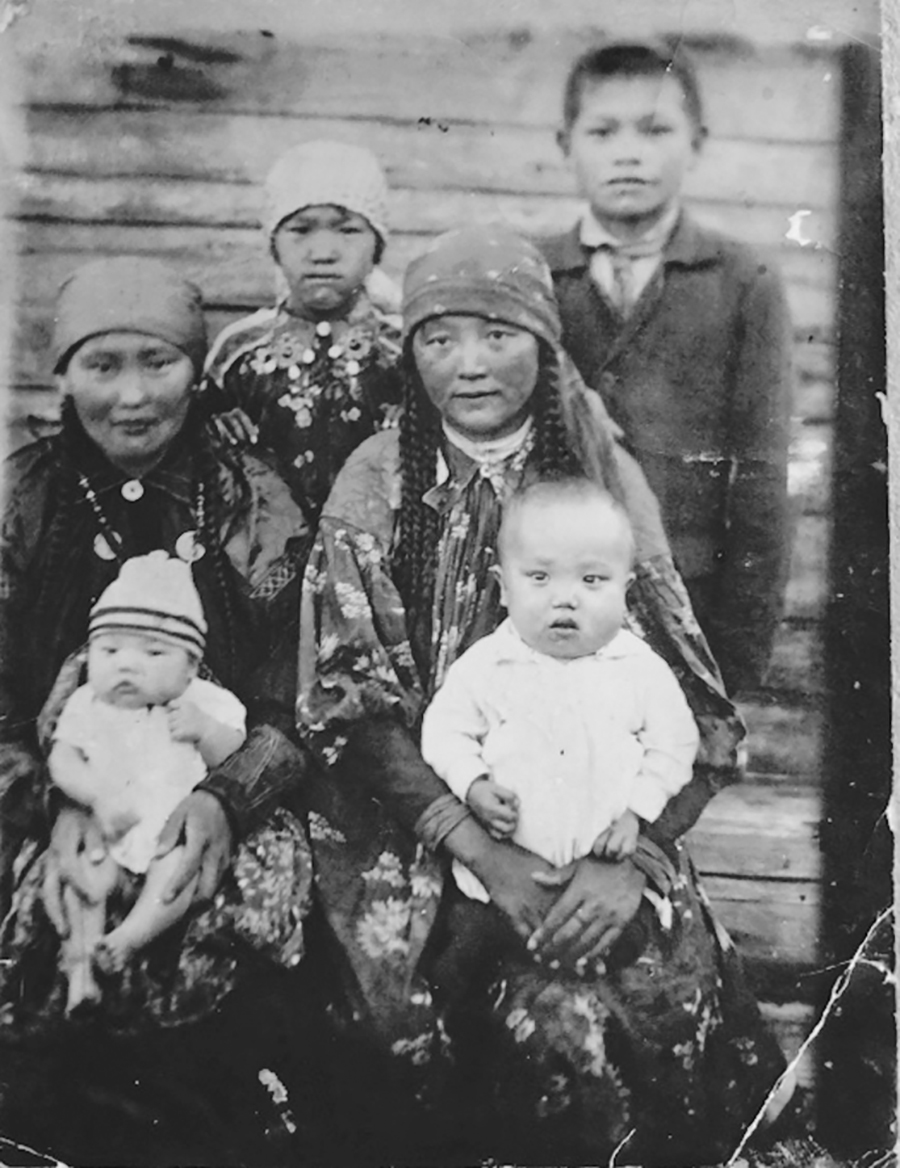
Relatives of Tülber Pögechi, Kindirlig piltiri (Ust'-Kindirla), Pii aimaghy.
|
6. Khubakh ool – ‘Kyrgyz’ horses
|
| Lyric song (saryn), Saghai people, as sung by Khubakh Chistanov from Khyzlas aaly (Kyzlas), Askhys aimaghy. Recorded by Aleksandr Kenel’ in 1945, published in his song collection Khakas chonynyng kögleri (Abakan, 1955). |
- Altyn Tan Tayas – khobyrakh (flute)
- Tülber Pögechi – topchyl-khomys (lute)
- Tagir Asochak – yykh (fiddle)
- Aycharkh Sayn – voice (khai in küülip and kharygha styles), chatkhan (wooden box zither)
- Lunic Ivanday – voice (khai in kharygha style), tüür (frame drum, shaman's drum)
- Mirgen Irgit – voice (khai in küülip style), müüs (horn rattle) |
| The song honours the exceptional strong horses of the ‘Kyrgyz’ breed that for centuries have been breed on Khakas territory. The rhythm imitates their solid, resolute trot. |
|
7. Küngürtü töstig – The tree that was burnt to its roots after lightning
|
| Lyric song (saryn), Saghai people. Recorded by Aleksandr Kenel’ in the 1940s, manuscript at the Archives of the Khakas Research Institute KhakNIIYaLi in Abakan. |
- Altyn Tan Tayas – voice, küngür-khomys (lute)
- Tülber Pögechi – topchyl-khomys (lute)
- Tagir Asochak – yykh (fiddle)
- Aycharkh Sayn – voice (khai in küülip style), chatkhan (wooden box zither)
- Lunic Ivanday – voice, timir-khomys (jew's harp), tüür (frame drum, shaman's drum)
- Mirgen Irgit – voice, khobyrakh (flute) |
| The song has a long-drawn melody on a few tones, typical for the Saghai people. |
| Even a tree that was burned to its roots after a lightning strike sprouts again. |
People, when they see this, start singing.
|
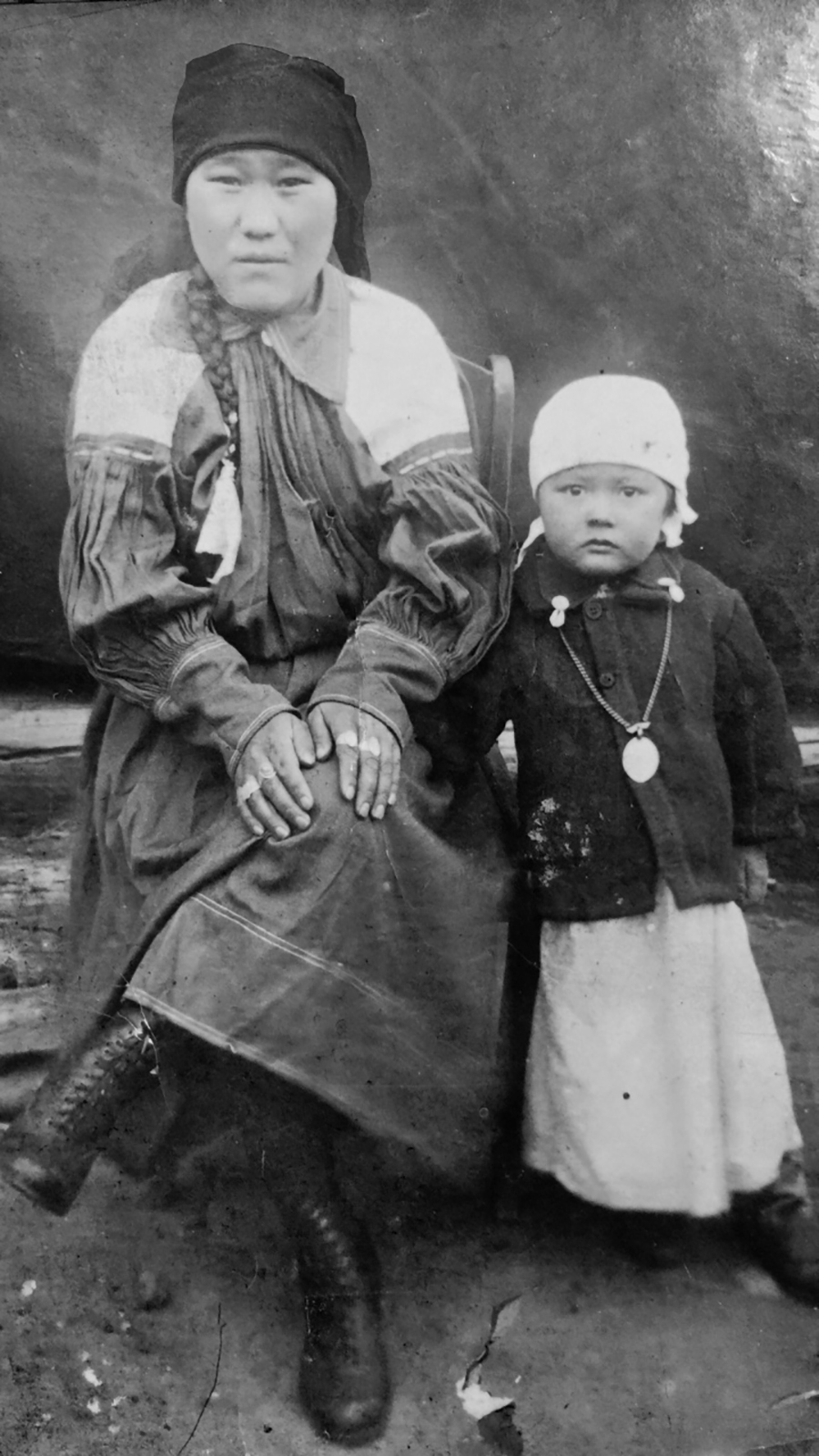
Relatives of Tülber Pögechi from Kindirlig piltiri (Ust'-Kindirla), Pii aimghy.
|
8. Khazykhtar – Sheep knucklebones
|
- Altyn Tan Tayas – küngür-khomys (lute)
- Tülber Pögechi – topchyl-khomys (lute)
- Tagir Asochak – yykh (fiddle)
- Aycharkh Sayn – chatkhan (wooden box zither)
- Lunic Ivanday – syylas (flute)
- Mirgen Irgit – khongyros (leather rattle) |
Instrumental about the children’s knucklebone game khazakhtar (known as chak), played with the same sheep knucklebones as those placed under the strings of the chatkhan (wooden box zither) and bound together as the khazykhtar (percussion instrument).
The musicians improvise this instrumental “because in childhood we all used to play the knucklebone game”. It imitates the game as if everone in turn throw the bunch of knucklebones. |
|
9. Khyrghys yry - Song of the Khyrghys söök*
|
| Lyric song (yr), Khaas people, as sung by Mirgen Irgit’s great-grandmother Anna Sarlina from Arshan aal (Arshanov), Altai aimaghy. Recorded at an aitys (singing contest) in 1986, stored at the Khakas Radio Archive in Abakan. |
- Altyn Tan Tayas – küngür-khomys (lute)
- Tülber Pögechi – topchyl-khomys (lute)
- Tagir Asochak – yykh (fiddle)
- Aycharkh Sayn – voice (khai in küülip, kharygha and syghyrtyp styles), chatkhan (wooden box zither)
- Lunic Ivanday – syylas (flute)
- Mirgen Irgit – voice (khai in küülip style) |
| Mirgen’s great-grandmother always sang this song about her ancestry when relatives arrived to visit her in Arshan aal. It has a unique melody. |
*Söök literally means ‘bone’ and refers metaphorically to the ‘bone’ of kinship: the clan in the male line, which in Khakas patriarchal society persists over time. Its counterpart is khan, literally ‘blood’: the corresponding kinship relationship in the female line, which is regarded as fluid as it dissolves in the male line (the söök).
|

Tülber Pögechi
|
10. Noozy artykh – What's more precious?
|
| Lyric song (saryn), Shor* people. Recorded by Aleksandr Kenel’ in the 1940s, published in his song collection Khakas chonynyng kögleri (Abakan, 1955). |
- Tülber Pögechi: voice, topchyl-khomys (lute)
|
| A philosophical reflection on what is important in life: |
What’s most precious in the dense taiga? – The healthy wild game roaming around there.
What’s most precious among the people? – Girls with many sürmester braids. |
Girls used to wear their hair in numerous sürmester as a sign of their unmarried state. (See also lyric song no° 14, Sas toi.)
|
*Shors are Turk-speaking people living in Southern Siberia in the Oblast Kemerovo in today’s Russia, mainly along the rivers Kondoma and Mras Su in the upper part of the Tom. This region is historically designated as Mountainous Shoria.
Shors also live in today’s Khakassia and in the Republic of the Altai. The ethnonym Shorzi, the name of the people, came into use in the middle of the nineteenth century. Previously, they had been considered in official sources as indigenous peoples of Siberia, often as Kuznetskie, Kondomski or Mras-Su Tartars. Many modern Shors still know their mother-tongue. The elder generation still uses this language within the families, while the children are taught this old language in boarding schools.
The Shor as a people are the result of a long process of development between the Turk, Ugrian, Samoyedic and Ket speaking tribes. Their culture and origin is similar to that of the northern people in the Altai region and that of the Khakas. They were mainly hunters, fishermen, farmers and blacksmiths. They maintained Shamanism and Animism as part of their tradition. They still live in the original territories of the Shor National Park that was founded in 1989, in about 35 villages. Mount Algan is their spiritually holy location of power, where rites and rituals are being performed.
The lifestyle of the Shors did change following the October Revolution in 1917. Today they are farmers, breed cattle or work in the iron ore mines.
|
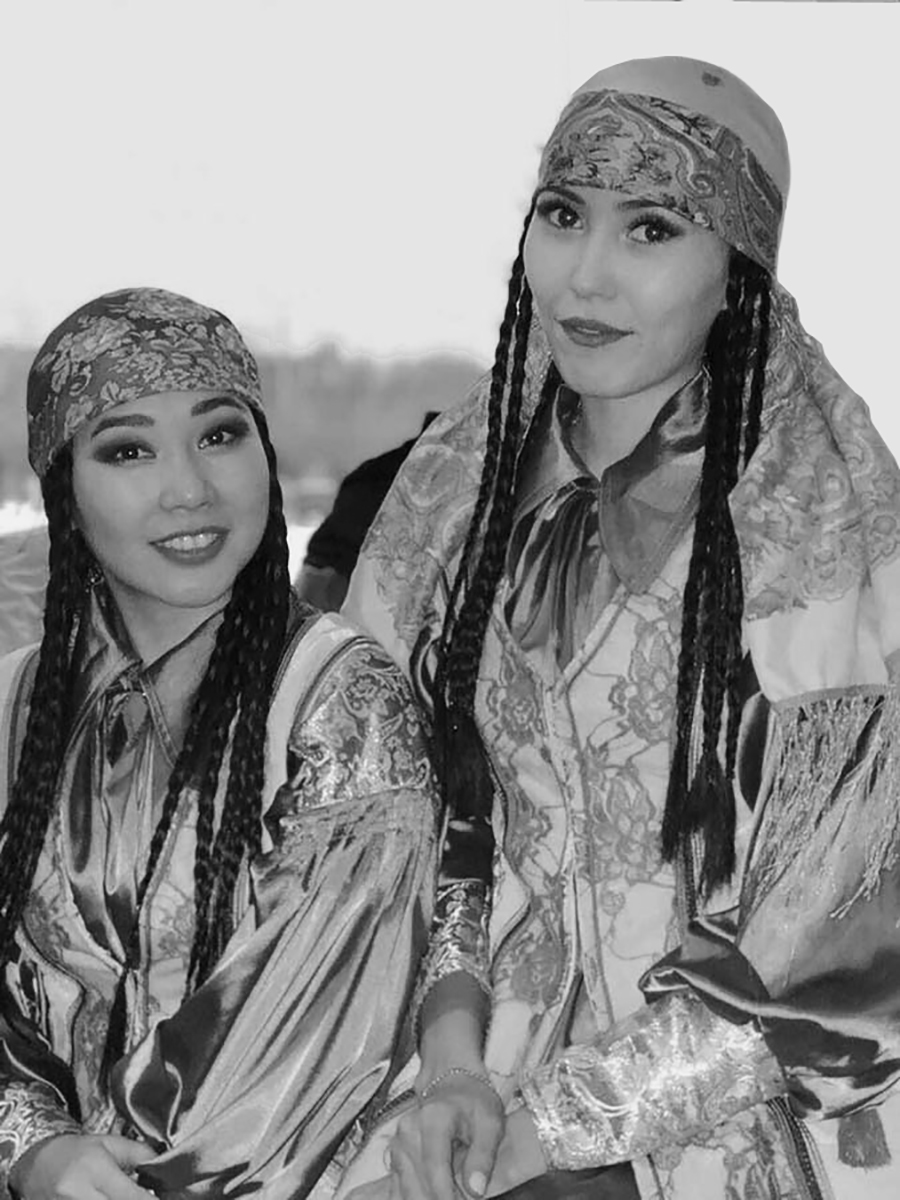
Unmarried girls used to wear their hair in sümester.
|
11. Küres – Wrestling
|
| Instrumental based on an old Saghai melody recorded by Aleksandr Kenel’ in the 1940s, manuscript at the Archives of the Khakas Research Institute KhakNIIYaLi in Abakan. |
- Altyn Tan Tayas – küngür-khomys (lute), khobyrakh (flute)
- Tülber Pögechi – topchyl-khomys (lute)
- Tagir Asochak – yykh (fiddle)
- Aycharkh Sayn – chatkhan (wooden box zither)
- Lunic Ivanday – syylas (flute)
- Mirgen Irgit – khazykhtar (sheep knucklebones) |
| This instrumental depicts Khakas traditional wrestling in sound. Khakas wrestling took place on the grassland near the settlement, and whenever people gathered for celebrations. Today it is performed at the occasion of the tun pairam celebration of the first mare’s milk in June. |
| (See more information in section Worldview, ceremonies and rituals.) |
|
12. Tang yry – Sunrise
|
| Lyric song (yr), Shor* people. Recorded by Aleksandr Kenel’ in 1945, published in his song collection Khakas chonynyng kögleri (Abakan, 1955). |
- Altyn Tan Tayas – voice, küngür-khomys (lute)
- Tülber Pögechi – voice, topchyl-khomys (lute)
- Tagir Asochak – yykh (fiddle)
- Aycharkh Sayn – voice (khai in kharygha style), chatkhan (wooden box zither)
- Lunic Ivanday – voice (khai in kharygha style), tüür (frame drum, shaman's drum)
- Mirgen Irgit – voice, khobyrakh (flute) |
| The song has a melody typical of the Shor* people, the Khakas’ Turkic-speaking neighbours to the west. |
| When the sun rises, it spreads its bright, colourful light. |
| When the sun has risen, we hear the voice of the lark. |
*Shore people for more information on the Shors, see lyric song no° 10 Noozy artykh. |
|
13. Chazy yrlary – Song of the steppe
|
| Instrumental based on an overlooked composition by the Khakas composer Nina Kataeva (º1937). |
- Altyn Tan Tayas – khobyrakh (flute)
- Tülber Pögechi – topchyl-khomys (lute)
- Tagir Asochak – yykh (fiddle)
- Aycharkh Sayn – chatkhan (wooden box zither)
- Lunic Ivanday – küngür-khomys (lute)
- Mirgen Irgit – sang (hand bell), khongyros (leather rattle) |
This instrumental vividly visualizes the broad Khakas steppe with its rich palette of herbs and flowers and mountains emerging in the far distance.
|
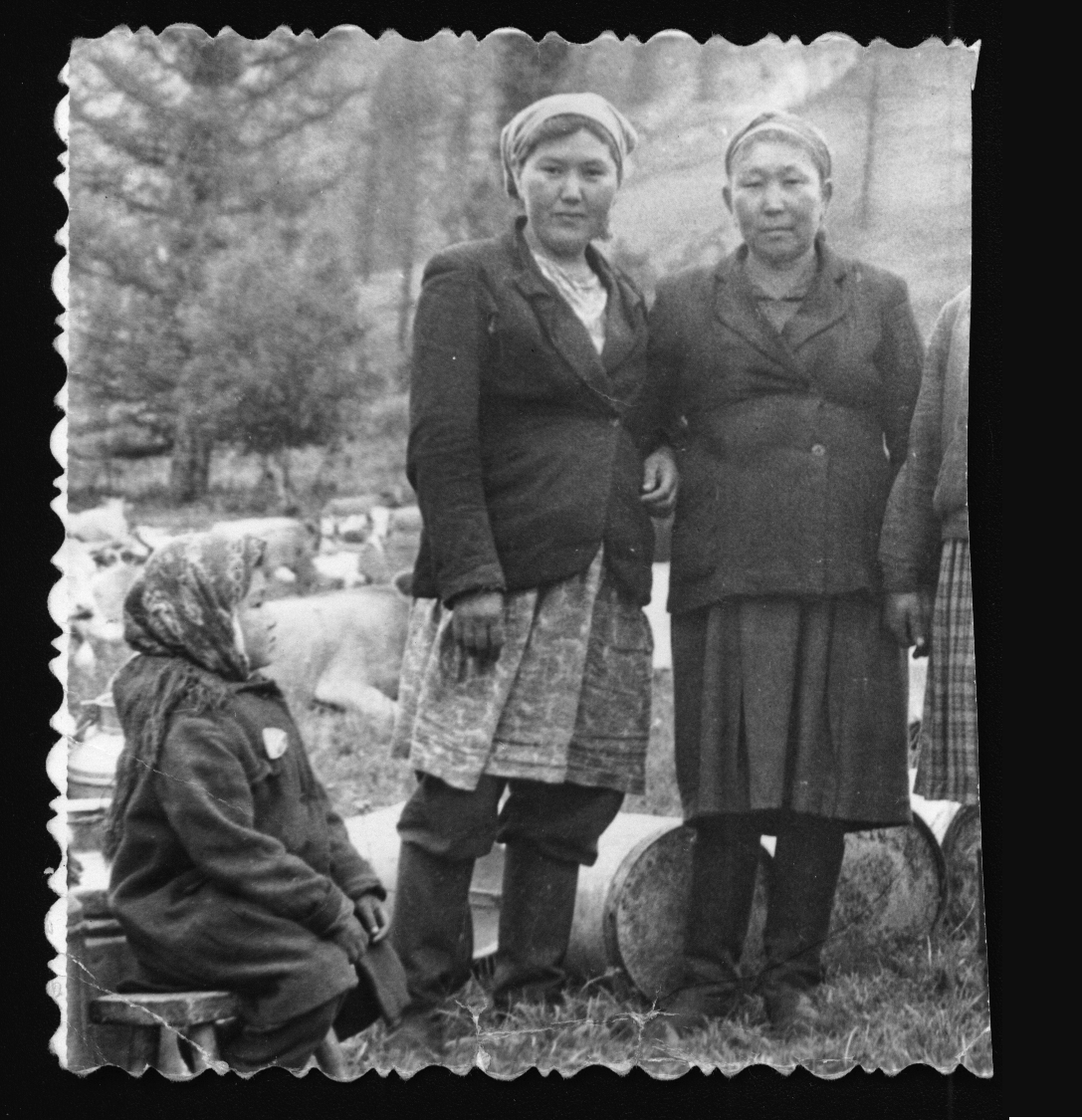
Mirgen Irgit's mother Lidia Kongarova (seated) and grandmother Paraskovia Sarazhakova (on the right) in Tabat taigha, Pii aimaghy.
|
14. Sas toi – The engagement party
|
| Lyric song (yr), Khaas people. In 1945 recorded by Aleksandr Kenel’ in Abakan. |
- Altyn Tan Tayas – voice, küngür-khomys (lute)
- Tülber Pögechi – voice, topchyl-khomys (lute)
- Tagir Asochak – voice, yykh (fiddle)
- Aycharkh Sayn – voice (khai in küülip and kharygha styles), chatkhan (wooden box zither)
- Lunic Ivanday – voice, tüür (frame drum, shaman's drum)
- Mirgen Irgit – voice |
| Songs like this were widespread and sung at the sas toi engagement party (literally: “hairparty”), when the numerous braids (sürmester) of the girl are untied and rebraided into two plaits. |
| This particular song is about aragha, the local alcoholic beverage consumed on occasions like this. |
|
15. Köcheg – Migration
|
| Lyric song (saryn) by Aycharkh Sayn, Saghai people, Sapron aaly (Safronov), Askhys aimaghy, Abakan, after a recording from 1945 by Aleksandr Kenel’, published in his song collection Khakas chonynyng kögleri (Abakan, 1955). |
- Altyn Tan Tayas – küngür-khomys (lute)
- Tülber Pögechi – topchyl-khomys (lute)
- Tagir Asochak – voice (khai in kharygha style), yykh (fiddle)
- Aycharkh Sayn – voice (khai in syghyrtyp style), chatkhan (wooden box zither)
- Lunic Ivanday – voice (khai in kharygha style), tüür (frame drum, shaman's drum)
- Mirgen Irgit – voice (khai in küülip style), sangyros (metal ring rattle) |
| To be in motion in the central topic for this album in order to highlight the importance of being and staying in motion so that one’s mind remains clear. To say it with a Khakas proverb: |
Standing water becomes swamp.
Flowing water remains clear.
|
| This song is inspired by a lyric song (saryn) of the Shor* people of Tashtyp aimaghy. The refrain “pooi, pooi, pooi ...” imitates the call the Shor people used while driving their cattle from the winter stables up to the high summer pastures at the river Arbat in spring, and back down in autumn. |
*Shore people for more information on the Shors, see lyric song no° 10 Noozy artykh.
|
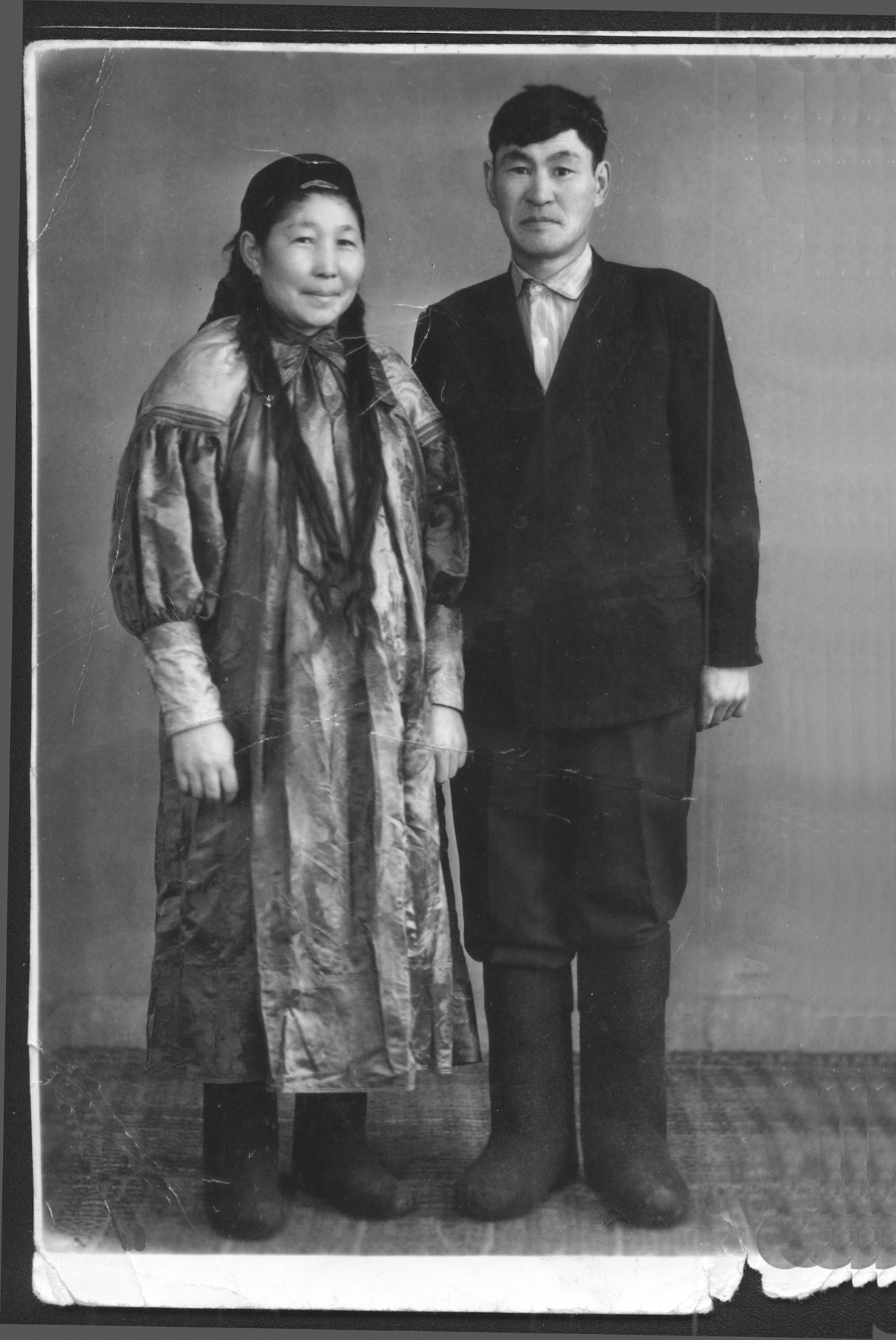
On the right side Mirgen Irgit's grand-parents Paraskovia Sarazhakova and Aleksei Kongarov in Pii aal,, Pii aimaghy (she was a takhpakchy a singer of songs with improvised text).
|
16. Taigha ünneri – Sound of Taiga
|
| Instrumental by Lunic Ivanday, Saghai people, Baza Pii (Beiska), Askhys aimaghy, Abakan. |
- Lunic Ivanday: timir-khomys (jew's harp)
|
| In their spare time while pasturing livestock or haying, people entertained themselves by playing the timir-khomys (jew’s harp) or the khobyrakh (flute). They improvised on existing song tunes and imitated the sounds of the surrounding nature. |
When Lunic improvises on the timir-khomys, he imagines himself back in the taiga close to the village of his childhood, and envisions what he hears there and what his inner world feels like there.
|
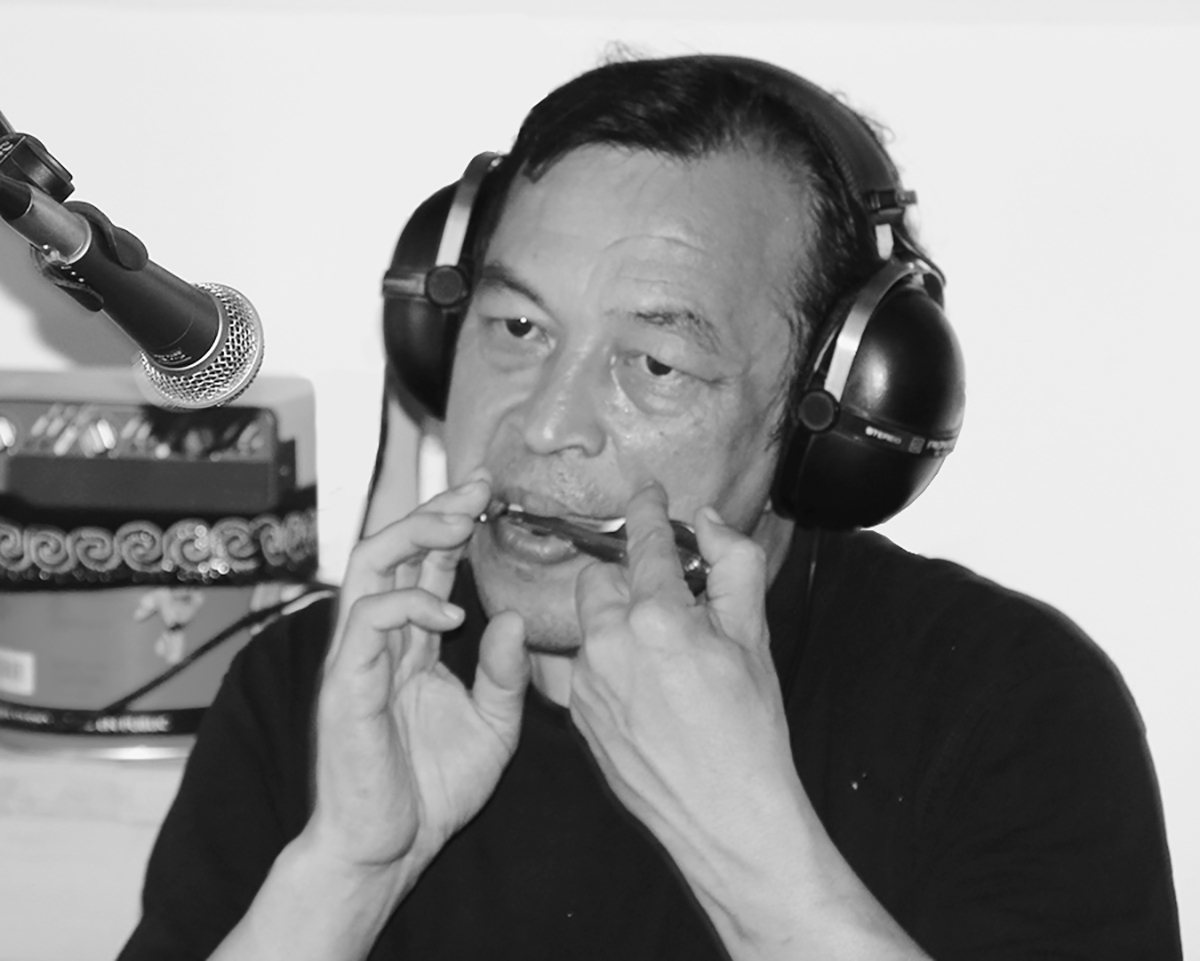
Lunic Ivanday
|
17. Khalyn churt – Life in abundance
|
| Lyric song (yr), Khaas people. Recorded by Aleksandr Kenel’ in the 1940s, manuscript at the Archives of the Khakas Research Institute KhakNIIYaLi in Abakan. |
- Altyn Tan Tayas – voice, khobyrakh (flute)
- Tülber Pögechi – voice, topchyl-khomys (lute)
- Tagir Asochak – yykh (fiddle)
- Aycharkh Sayn – voice (khai in kharygha style), chatkhan (wooden box zither)
- Lunic Ivanday – voice (khai in kharygha style), tüür (frame drum, shaman's drum)
- Mirgen Irgit – voice (khai in küülip style), tuighakhtar (horse hooves) |
This song is about the good life of the Khakas people. The have fat pastures, with the cattle thriving. The people lead a life in abundance. (see also song 1 Chyrghalygh churtas).
|
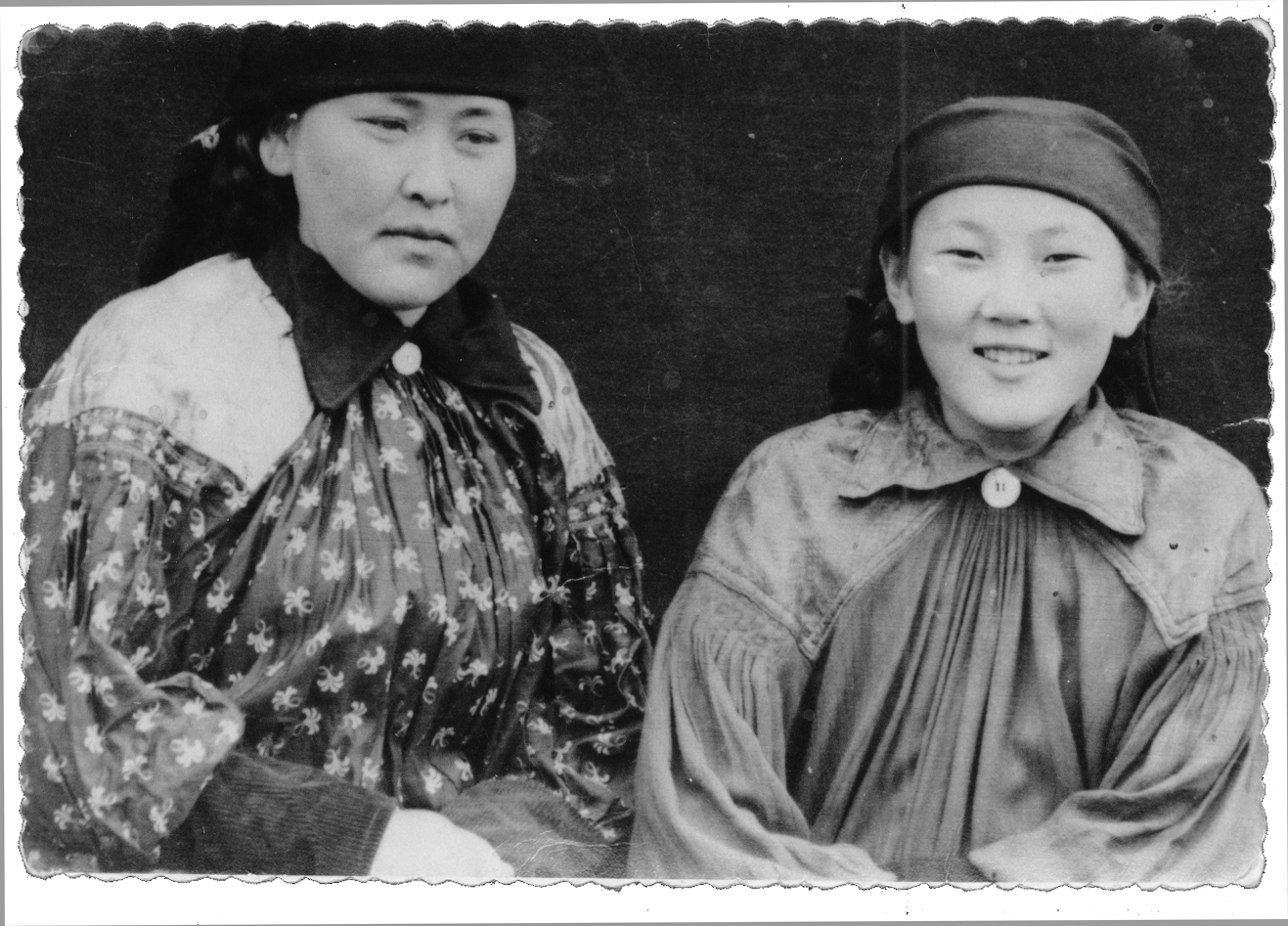
Sister of Mirgen Irgit's grandmother, thakapakhchy Paraskovia Sarazhakova in Sapogov aal, Aghan-plitir aimaghy, early 1950s.
|
Performing arts
The Khakas people have a rich tradition in storytelling, performing epics in poetry and in prose, proverbs, sayings, wise phrases and riddles, fixed and improvised songs, dirges and laments, wedding songs, lullabies, working songs and game songs.
Text always prevails over music. These linguistic tools are means to tell or sing stories in a convincing and persuasive way. Poetry does have the power to enchant the audience, and for this reason it is performed according to fixed rules. Contextually, poetry is formed on observations regarding parallelism between human experience and natural surroundings.
The Mongols also know songs that are existent in verse form, without any refrain proper, with full vocal power and in the highest register. The melody is surrounded by a “coat“; there is sung a range of more than three octaves; the Khakas songs, however, are rather limited, covering frequently only one octave, with that of the Saghais restricted frequently to only one fifth. These songs are always subject to rather strict rules of presentation and performance. The form is quatrains, and the beginning of every single line is determined by the same vowel of the first word. Texts are adopted by other singers, and there are added some new improvisations: in this way, long stories (songs) are generated and created. The Mongolian people definitely sing these long songs when they are out alone in the steppe and only riding rather slowly. The repertory is a symbol of the freedom and the vastness of the Mongolian steppes and also accompanies cyclic rites of the year and ceremonies of everyday life. Long songs are also an integral part of festivities taking place in the round tents. Among the Khakas, however, such songs are not very common, it is further prohibited to sing in the open steppes or in the taiga, as this might attract the evil spirits. The Khakas also do not distinguish between long and short songs. For rites, there are used alghys (prayers, blessings, thanks), and in gatherings and meetings there are performed alghys and takhpakh (improvised songs).
In the Khakas society creativity has a supernatural source; it is conveyed in the dreams of the people. Such gifts and talents are not only handed down in a line (family), but they may also be awarded to individual persons. Due to the gifts provided by the owner spirits, man and woman are gifted. Skilled story tellers of epics (nymakh), as well as singers singing improvised songs, are supported in their performances by the owner spirits.
Every man and woman can be awarded the gift of creativity by a spirit. Skilled and gifted storytellers of epics and singers of improvised song (takhpakh) are supported during their performances by the spirit owners of nymakh, khai, or takhpakh. They receive instructions and inspiration in their dreams, and are inspired and supported while performing.
Songs were performed at all events where people met spontaneously or on organization, but especially at festive family gatherings and singing contests. People were allowed to sing at day and night, but only in and around the house and the village. For this reason, the Khakas, as opposed to the Tuvin, Altaian and Mongolian people, did not sing songs when travelling or riding the horse across the steppes. Singing in steppe, taiga and mountains is prohibited because it attracts evil spirits. The Khakas people therefore, unlike the Tuvans and Mongolians, do not have travel songs. Most songs can be performed by men and women alike, except for the songs that belong to gender-specific activities, such as (lullabies) cradle songs and work songs. In general, however, songs without throat singing are mainly performed by women, whereas epic storytelling using throat singing is more or less limited to men.
Some songs are integral part of specific occasions like family festivities and year-cycle ceremonies. Blessings (alghys) were recited or sung for welcoming and leave-taking. Love songs, courting songs as well as confirmation of marriage and dowry negotiations formed a rather impressive repertoire. In the context of death, various kinds of dirge (syyt) are sung. In the first year after death ritual dirges are performed: söök syydy (“lament over the corpse”) before and during the funeral and ibirig syydy (“lament at a post-funeral wake”) at the wake, to see off the souls of the deceased and thus ease the passage of the deceased into the other world. Later, people sing non-ritual dirges at home in order to commemorate the beloved.
The Khakas people have also songs that are not bound to specific occasions: takhpakh, a song with an improvised text, and saryn or yr, a song with set text and melody. With these songs, performed solo, performers can freely express themselves, sometimes to the accompaniment of a string instrument. Takhpakh are spontaneously improvised texts and give a description of the surrounding nature, one’s home country, a gathering or meeting, or another singer. Takhpakh singers show their talent in special singing contests called aitys. In such competitions two singers alternately compete with constantly improvised verses on a limited number of melodies, and try to outdo each other in originality and wit. Such singers are supported by their spirit owner, who gives them the ability to perform such inspired texts. Set songs are called yr (Khaas, Khyzyl and Khoibal) or saryn (Saghai and Piltir), having more verses, an elaborated theme, and often more distinguished melodies. The majority of these songs are lyric songs, into which the performer integrates own thoughts and feelings about life and past events; some are work, game, or dirge songs.
The repertoire comprises a small group of dirge songs or laments (syyt) that are designated as lyric songs; dirge songs are ritual songs; laments having improvised texts are performed by a singer and tell of the person deceased and those he has left behind. Personal laments may be taken over by other singers, thus being slowly integrated into the common song repertoire.
Other dirge songs stem from epics or stories (kip-chookh) and constitute the oldest surviving form of the Khakas folklore. Laments are complaints about one’s misfortune, misery or suppression and are also often called “yr” ("song"). These laments are often sung by animals or human beings who have turned into animals and who sing about their harsh living conditions or unfair treatment - another display of the parallels to suppression and the life as vassals shared by the people.
The most prominent Khakas storytelling tradition is epic stories (“epic with a hero”) performed by specialized storytellers at meetings and gatherings during long winter nights – also to accompany souls into other worlds, or before hunting to please the spirit owner of the animal to be given the permission to shoot deer. Performance with throat singing and the box zither or lute was reserved for male performers and called “epic with a horse”. Unaccompanied recitals, being performed with intoned speech voice, are called “epic on foot” and may also be performed by women. An “epic on horse” sets off with an instrumental prelude. Then the storyteller tells the story alternating with throat singing and with repeated text having temporary shifts to a higher or lower tone and with unaccompanied intoned speech. The overtones of the throat singing create an extraordinary timbre texture that brings about the supernatural time-space feeling, in which the epic world comes to life. Every now and then the story is suspended with an instrumental interlude, a blessing, well-wishing expressions, songs or laments.
The most talented storytellers are provided with inspiration by their spirit owners and they are called eelîg khaijy (kaichi). They could endlessly sustain their performance. Such a story could last for several nights in a row, being interrupted only by short breaks. The storytelling tradition was continued without any interruption by Khyzyl storytellers until the 1970s. Among the last great ones were Semyon Kadyshev (1885-1977), who lived among the Khaas people near Lake Shira, and brother and sister Pyotr Kurbizhekov (1910-1966) and Anna Kurbizhekova (1930-1990), who lived along the Üüs river.
Prose stories, which are called “kip-chookh”, are told by women as well as men and include sacred myths about the origin of the world, creator spirits, spirit owners and other supernatural spirits; stories and legends about historical heroes, shamans, ancestors of the tribes; as well as humorous tales and fairytales. The most comprehensive kip-chookh stories, just like alyptygh nymakh stories, “epic with a horse”, include songs, dirge songs, and laments.
Epics (stories) and singing were accompanied by string instruments. In this way, the gait of a horse was imitated, or the adventures of a hero were being emphasized. Hunters used various wind instruments to imitate animal calls and thus attract the desired game. When people played flutes, string instruments or the jew’s harp, it was mainly for personal entertainment. They improvised on standard melodies, or they spontaneously created their own melodies, being inspired by the sound of the environment or closer surroundings.
Such rich creativity is awarded by a supernatural source, conveyed in the dreams of the people. Such gifts and talents are handed down in a line (family) and on the basis of their ancestors. Men and women alike are supported by spiritual powers, which are independent but, however, still responsible for the epics performed in throat singing. These spirits protect and support the “khaijy”, the storytellers of epics, and takhpakh, the singers of improvised songs.
Traditional vocal techniques
- Khai (throat singing – guttural singing)
Khai (or kai, as it is called among the Altaian and Shor people) is the traditional form of overtone singing from the north-western Sayan-Altai region, with only the highest and lowest vocal registers being used. It is largely a male vocal technique, though women are known to have performed and to perform it as well. It is inextricably linked with heroic storytelling, epics with a hero / heroine; it is in high esteem and constitutes an important part of the cultural heritage.
Throat singing and overtone singing is a common feature of all southern Siberian Turkic, many Mongolian, as well as some Kazakh peoples. It is also performed by many Turkic tribes in Central Asia. Overtone singing is a very special technique, wherein a single vocalist produces simultaneously two distinct tones. In its clearest (Tuvan and Mongolian) form, one tone is a low fundamental pitch that is sustained like a drone, while the second is a series of flutelike harmonics that resonate high above this drone. A real master may amplify the overtones at the expense of the fundamental pitch, even to the point that the drone becomes inaudible. Another technique often used combines a normal glottal pitch with a low-frequency pulse-like vibration, known as vocal fry. Texts are usually sung in such a vocal fry of about 25-20 Hz. The Shor and the Khakas people do not usually sing their texts in such a fundamental pitch, as they use kharygha more sparingly.
Unlike the Tuvans and the Mongolians, the more northern located Khakas, Altai and Shor people do not express the overtones very much in their khai or kai. Khai is produced by generating a fundamental tone while pressing the diaphragm and slightly pressing together the vocal cords. In this way, a hoarse sound arises, accompanied by soft overtones that change with the vowels of the recited text, thus creating a multi-layered sound hovering above the basic drone. Primarily, the epics are performed together with a string instrument. In the Khakas tradition, however, the overtones are rarely used to create a melody. Khai is not used to show virtuosity, but rather to convey texts in a convincing way; for this reason, this is only rarely performed independently. By using the technique of khai, the storyteller clearly emphasised the text, while at the same time making overtones subtly resonate above the recited text. The overtones help to reinforce the story’s text, as they create an extraordinary timbre texture that brings about the supernatural time-space feeling, in which the epic world and the story come to life.
- Kharygha, kharghyra (from khorlirgha, the Khakas word for snoring) or ulugh chon khai (“khai of the respected elders”) is the lowest sound a human voice can generate. This sound is related to the Altaian karkyra and the Tuvan kargyraa. It rises from the deepest part of the trachea and resonates in the chest. It is used for short episodes in heroic epics.
- Küülip or küveler means “humming” and sounds an octave higher than kharygha. It is related to the Altaian köömöi, the Tuvan khöömei, and the Mongolian khöömii, but focuses less on producing discernible overtones. It is the main style for storytelling. This style is often simply called “khai” because it is the only style that has survived the Soviet period.
- Syghyrtyp means “to whistle”. This is a style of overtone singing, wherein there are generated tones in the throat that are comparable with the wailing sounds of the wind. Overtones are created between cavity, pharynx and tongue. This style is related with the sygyt of the Altaian and Tuvan people, wherein the highest and brightest tones are generated as the highest register of the voice is used. (In nature, every single tone and sound has overtones; even the wailing of the wind has its overtone vibrations). Whistling is only sparingly used; it is only used for short melodies at the end of phrases; humming (küülip) is followed by whistling.
The old performers mostly used küülip to perform stories and songs. Performers today use khai (overtone) mainly for songs and, to a smaller extent, for prayers. Kharygha and syghyrtyp are as frequently used as küülip.
- See more information in the web under: Traditional music and instruments of the Mongolian people – Traditional Instruments of the Khakas and Altai people – Traditional vocal technique of the Khakas and Altai people.
|
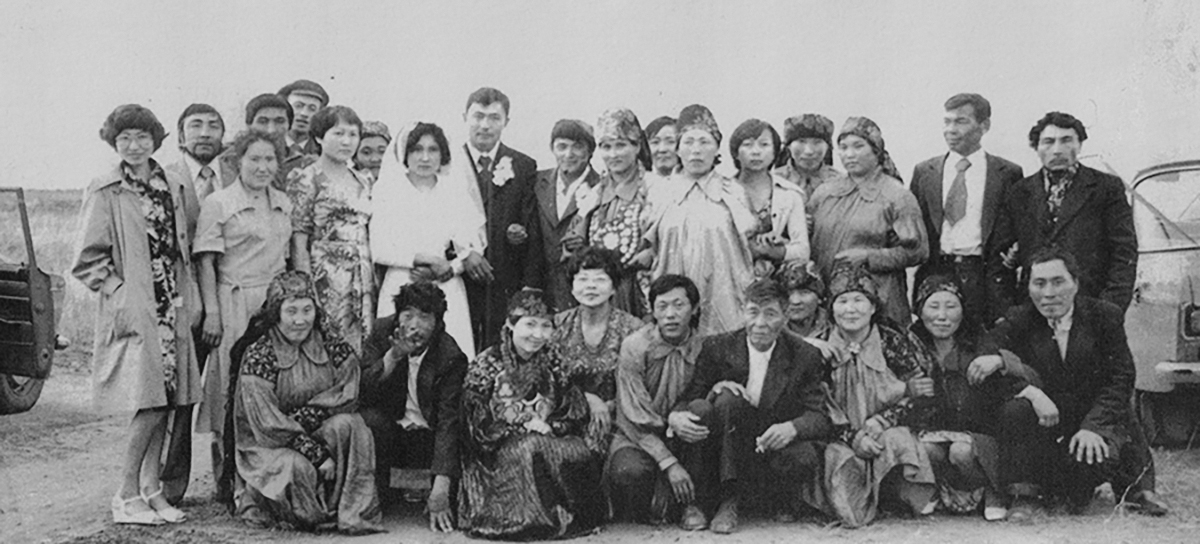
Wedding of relatives of Mirgen Irgit's mother, early 1980s. Arshanar aali (Arshanovo), Altai aimaghy. Mirgen's mother to the fast left.
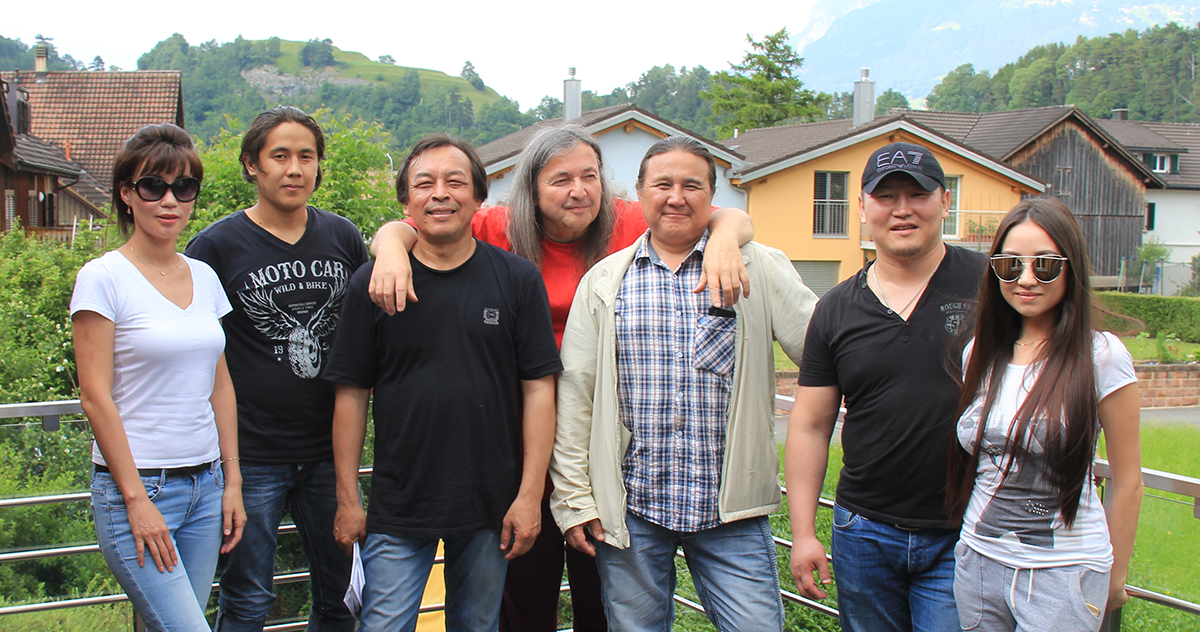
Ensemble: from left to right: Altyn Tan Ayas, Tagir Asochak, Lunic Ivanday, Fizzè, Aycharhk Sayn, Mirgen Irgit and Tülber Pögechi.
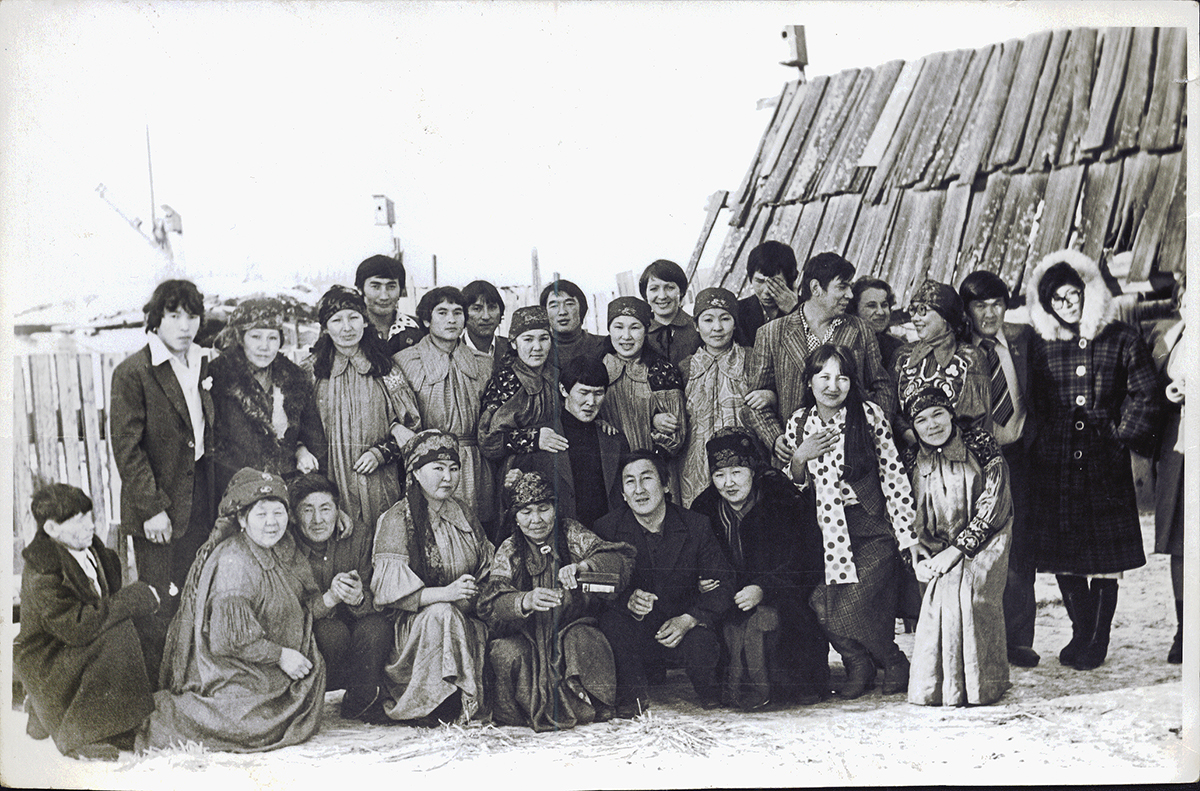
Wedding in Borchikov, in Kirba aal, Pii aimaghy, early 1980s.
|
Instruments:
|
|
 – aghas-khomys – aghas-khomys
|
- Khomys (string instument)
This is a two-string or three-string lute, related to the Altaian topshur, the Tuvan doshpulur and the Mongolian tovshuur.
The Khakas people play two types of khomys: the aghas-khomys and the topchyl-khomys. Both have a body and neck carved from cedar wood, but while the former has a wooden sounding board from cedar wood, the body of the latter is covered with the skin of wild roe deer, domestic goat, or cattle. The traditional stringing is of twisted horsetail hair, and the strings are tuned a fourth or fifth apart; the three-string khomys is tuned a fourth plus a fifth apart.

 – topchyl-khomys – topchyl-khomys
|
 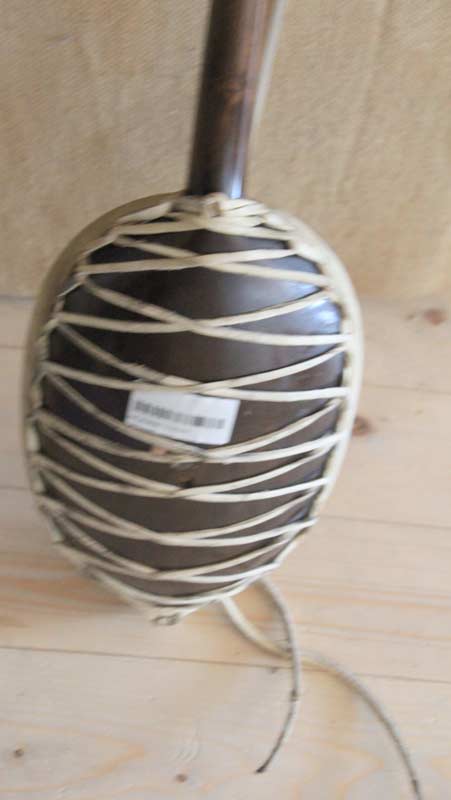 |
- Yykh (string instrument)
This is a two-string fiddle of the Khakas people, related to the Altaian ikili, the Tuvan igil and the Mongolian ikil.
Its body is similar to the khomys but has a longer neck. The body, like that of the topchyl-khomys, is covered with the skin of wild roe deer, domestic goat or juvenile cattle. The strings are made from twisted horsetail hair and are tuned a fourth or fifth apart. It is played with a bow made of willow branch with horsetail hair stringing, and it is coated with larch or cedar wood resin.


|
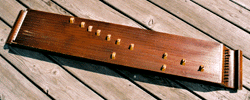
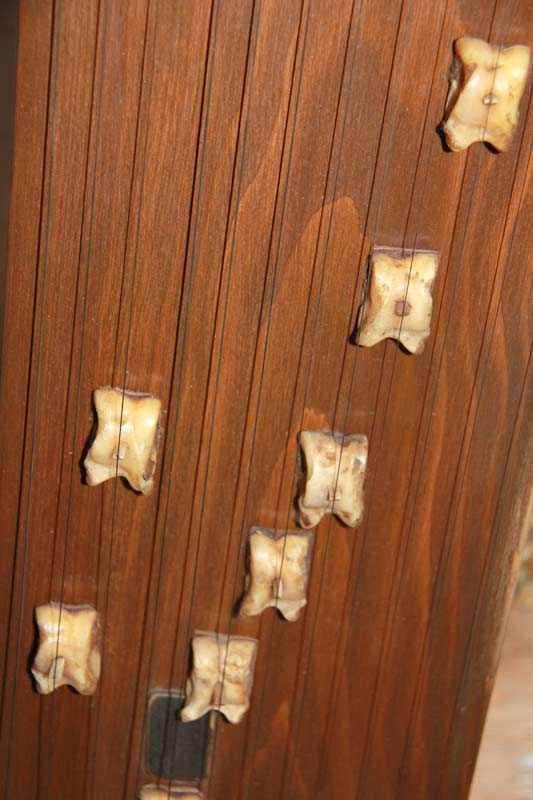
|
- Chatkhan or chadyghan (string instrument)
The chatkhan is the most prominent instrument of the Khakas people. It is a plucked long box zither with six to fourteen strings, distantly related to the Tuvan chadagan, Mongolian yatga, Japanese koto, Chinese quin and Korean kayagum.
The Khakas zither is a 1.5 metres long box from spruce wood, with each metal string running over an individual movable bridge made from sheep’s knucklebone. It is likely to originally have consisted of a short body (about 50 cm long) hollowed out from underneath like an upturned trough, with strings of horsetail hair.
However, in the 18th century it already broadly had its present shape: a long box of nailed boards with 6 or 7 metal strings. It has a rather smooth sound, ideal for performance in intimate company. The chatkhan is tuned in a pentatonic scale, with one or two strings tuned a fifth and/or octave below the lowest melody string, to obtain a drone. Some strings are also pressed to the left of the moveable bridge with the left hand, to raise the pitch. The strings are plucked and strummed to the right of the moveable bridges with the right hand to produce both melody and drone. The left hand is used to press particular strings to the left of the moveable bridge. In this way, diatonic melodies can be played on the pentatonic instrument, as well as the adorning gliding tones and vibratos so typical for the instrument.
Unlike the long zithers (yatga) of the Mongols, who mainly used the long zither at court and in monasteries since strings symbolised the twelve levels of the palace hierarchy, the chatkhan was used to accompany lyrical, historical and epic stories and heroic tales in intimate gatherings of common people, especially at weddings and nocturnal dead wakes.
The chatkhan (like the Khakas lutes) could hold a spirit, and therefore handling and playing was bound by taboos and rituals.

|
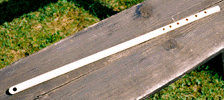
|
- Khobyrakh or Shoor (wind instrument)
Formerly an open end-blown flute similar to that used by the Bashkirs and the Caucasians. It was a 30 to 65 cm long, smooth, hollow pipe without finger holes, made of the stem of a large umbelliferous or willow cut on the spot. The Khaas tribe called it “khobyrakh” (lit. “hogweed”, a kind of umbelliferous), while the Saghai and Shor tribes called it “shoor”, like the Altaians, who locally also call it "shagur" or "komurgai" and which is similar to the shoor and the khobyrakh. It has, however, holes at the side and is made from wood. Its length is 30-40 cm.
Nowadays it has a small block with a slit at the top, six finger holes, and it is made of wood veneer (ash, mahogany and other species) or plastic.
|
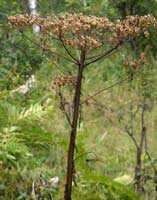
chervil

|
- Syylas (wind instrument)
An open end-blown flute similar to that used by the Bashkirs and the Caucasians. It is bigger than the khobyrakh (60-80 cm long) with four finger holes to the front and one to the back. It is made from the stem of the big chevil (parasol-like plant, designation for big umbelliferous plants) or from wood. Today it is mostly made from plastic.
Melodies are created via airflow by covering or uncovering the lower end, using a finger. As such a traditionally produced instrument is unsuitable for transport, rather fragile and frail, this instrument is nowadays made from plastics. Today, it often has 3 and sometimes even 6 fingerholes.

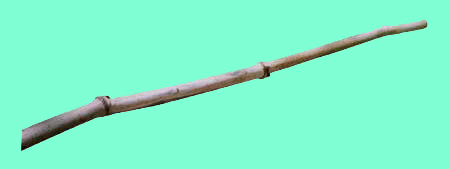 chervil
chervil
|
 |
- Timir-khomys – jew's harp.
This is a small horseshoe-shaped instrument to which a stiff spring is attached. Today it is made of brass or steel (timir-khomys literally means “iron utensil”) but in the past it was made of wood.
The player places the frame of the instrument with his left hand to his mouth, touching the front teeth, and taps the spring, which is called ‘tongue’, with his right hand. The instrument’s tongue acts as a vibrator, while the mouth cavity acts as a resonance chamber. The player can vary pitch and timbre by changing the shape of the mouth cavity, opening or closing the throat, and changing the attack on the instrument's tongue.
|
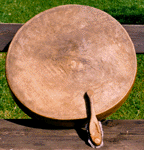
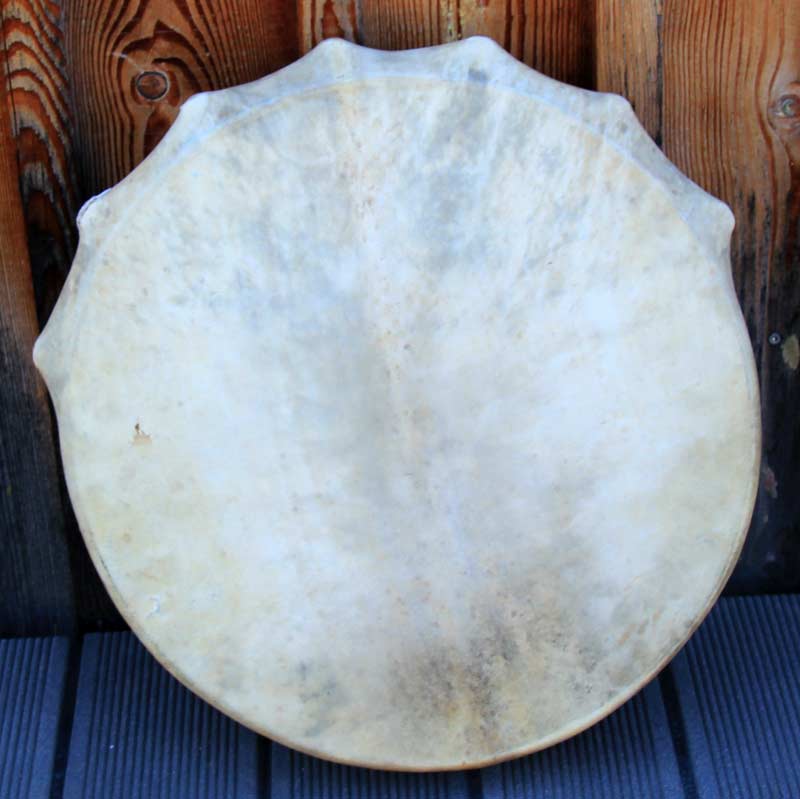
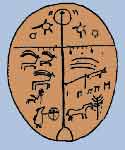
|
- Tüür - single-sided frame drum – shaman’s drum (tungur) – (percussion instrument)
The drum consists of a round wooden frame fixed inside with one vertical and one horizontal wooden stick and covered with the skin of a cloven-hoofed animal. Formerly it was only used as a ritual instrument by shamans (kham). Today it is also used as the main percussion instrument in music ensembles.
When used as a ritual instrument, drawings are made on the outer side of the drumhead, and coloured ribbons (chalama), metal bits and bells are attached to the horizontal stick inside. It is beaten with an orba, a drum stick made of wood and leather.
- Orba – drum stick 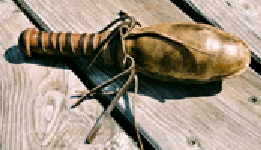
It is made of the urinary bladder of an animal filled with grain and has a handle.
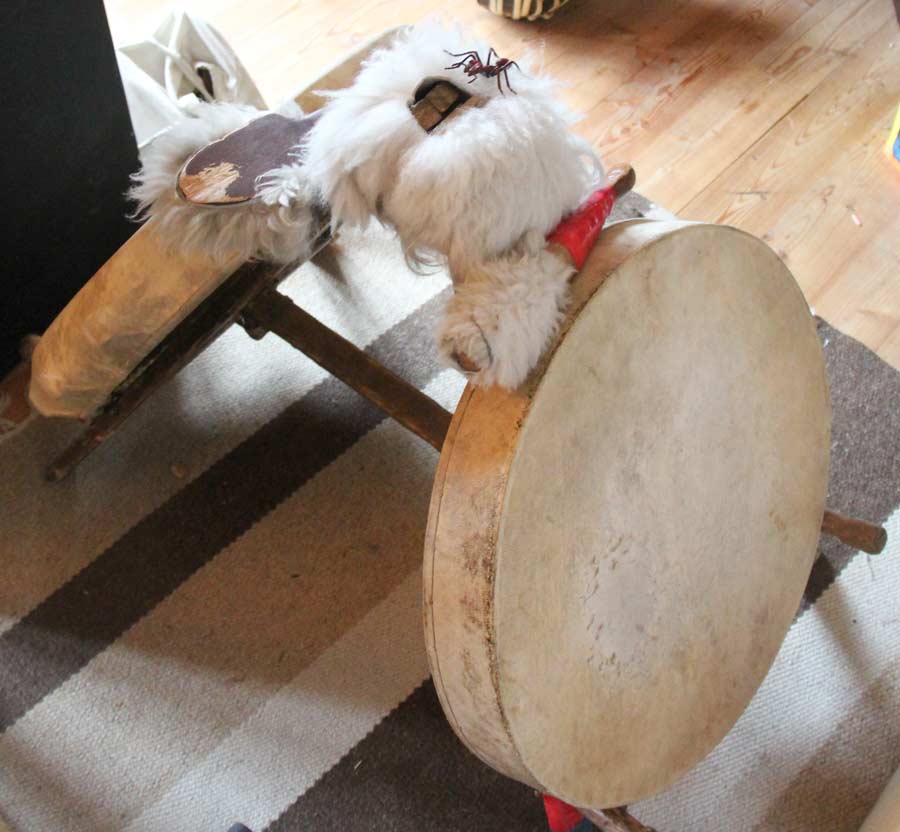 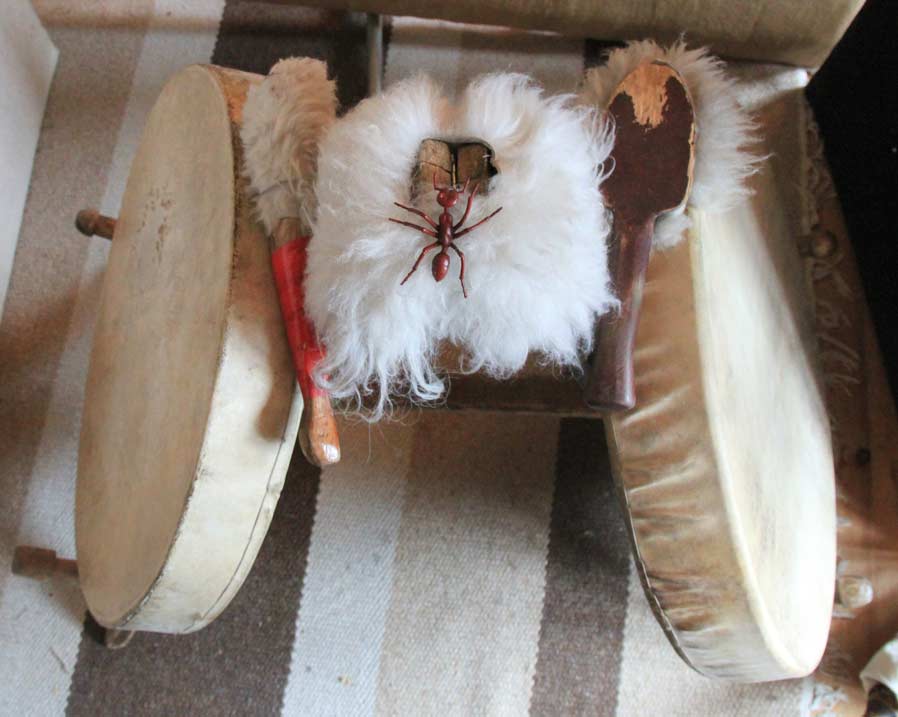
|
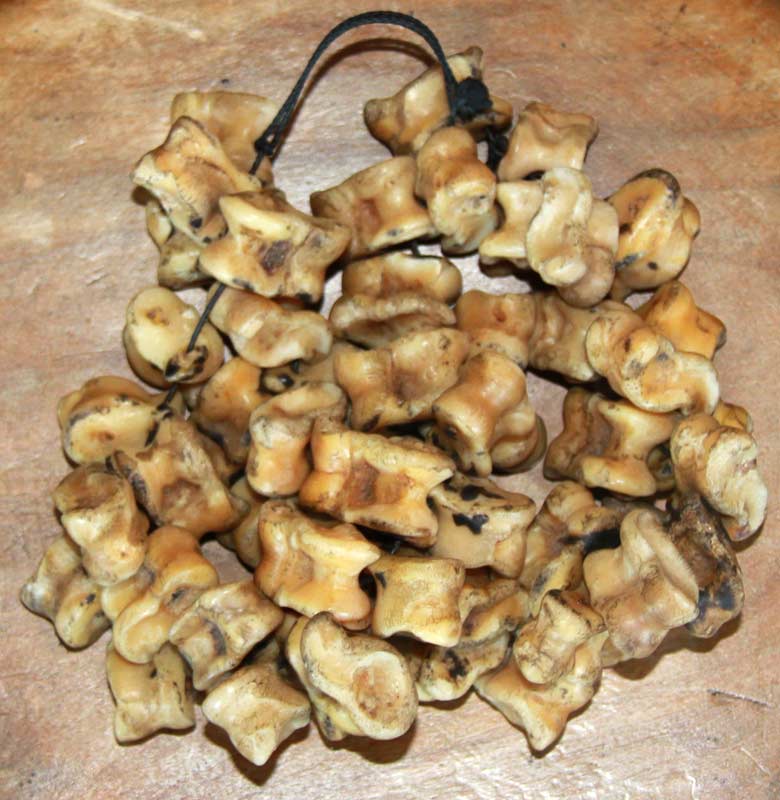
|
- Khazykhtar (percussion instrument)
Rattle of sheep knucklebones. |

|
- Khongyros (percussion instrument)
Made of leather and filled with grain. |
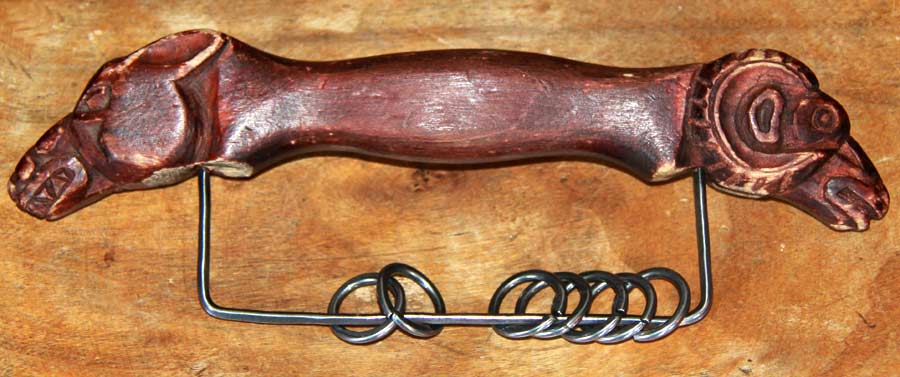
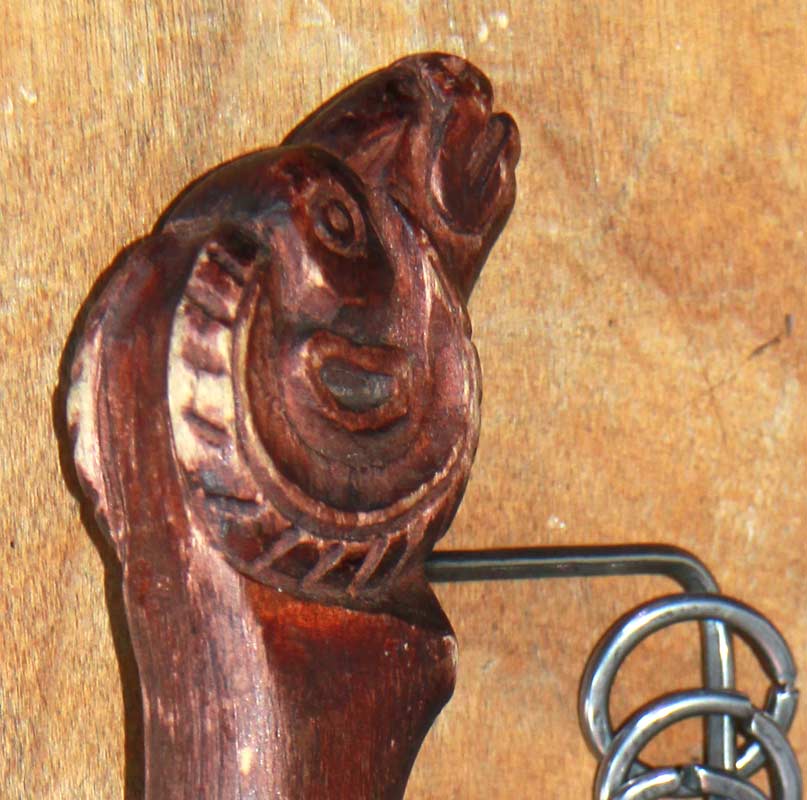
|
- Sangyros (percussion instrument)
Rattle with metal rings; ornamented with horse and ram head |
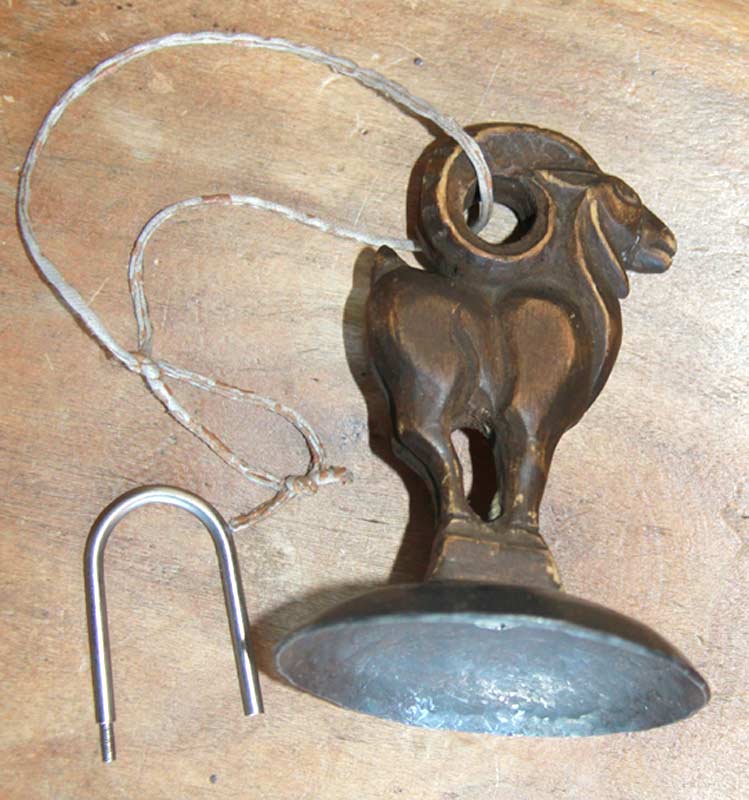
|
- Sang (percussion instrument)
Iron hand bell with a wooden handle in the shape of an ibex. |
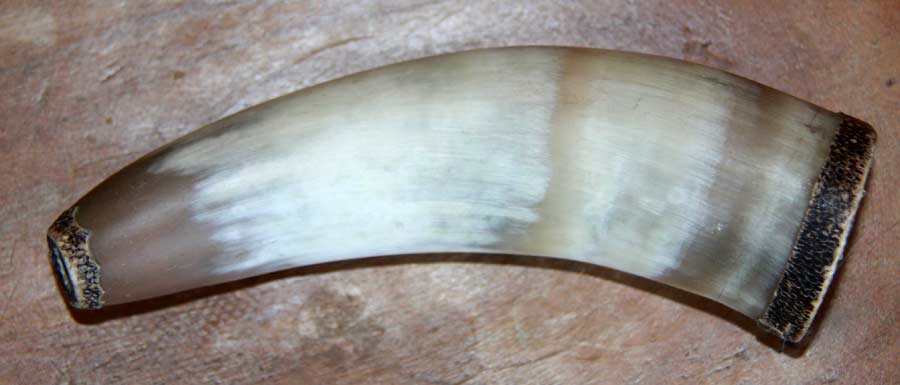
|
- Müüs (percussion instrument)
Rattle made of a cow horn; filled with small stones and closed with leather. |
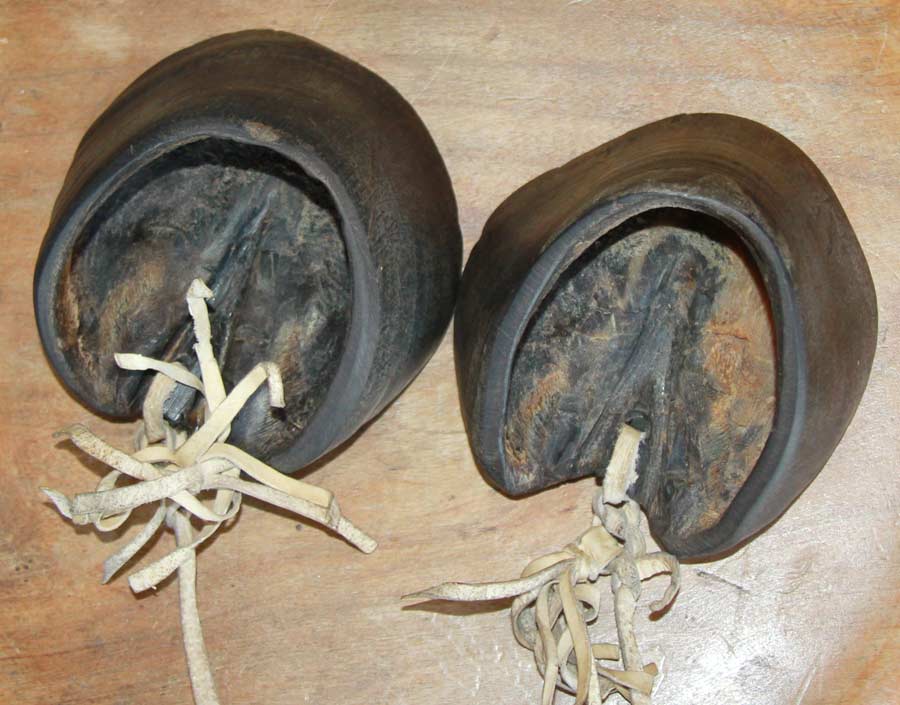
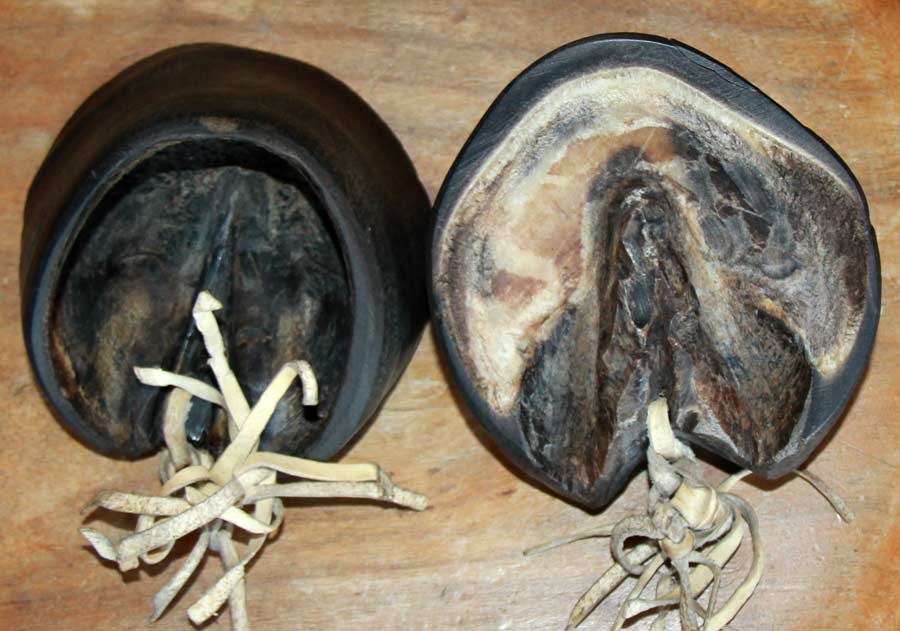
|
- Tuighakhtar - Paddock – hors's hoof (percussion instrument)
Horse hoove clapper. |
|
